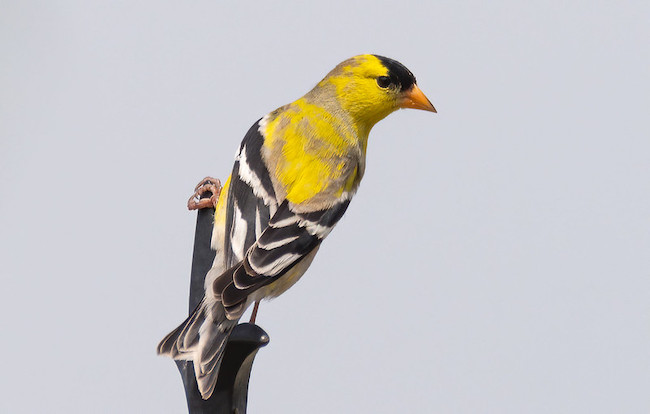If you’re a molt enthusiast, the past year has seen the publication of several studies by IBP biologist Peter Pyle that will be of interest to you. These are in addition to the focal paper revising the Wolfe-Ryder-Pyle age-coding system that was published in the journal Ornithology this past October. And even if molt is not your ornithological passion, and if this is the case you are not alone(!), these studies might convince you to take a closer look at the feathers on your favorite birds.
The regular replacement of feathers, or molt, is a crucial but physiologically demanding process in a bird’s life cycle. Understanding this process not only helps us know and appreciate the appearances of birds more fully; molt, or feather age, also provides an important set of clues that allow scientists to determine the age of individual birds. This is vital for bird conservation because the ability to estimate the age of individual birds is necessary to understand the health of a bird population. In addition, birds need certain specific locations and habitats to molt, and we are only beginning to determine and investigate these important areas in order to conserve them.
Pyle’s recent molt studies take both an applied and an evolutionary perspective. He has addressed molt in one of birds’ early ancestors, Archaeopteryx. Pyle coauthored a paper in Communications Biology that addresses possible evidence of molt in the Thermopolis specimen, a particularly complete and well preserved Archaeopteryx siemensii fossil found in Bavaria.
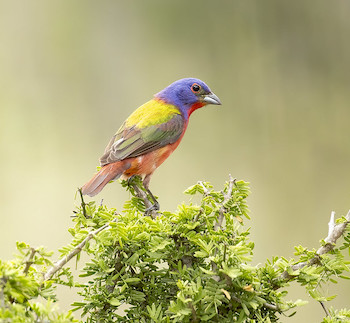
A male Painted Bunting. Photo by Mick Thompson.
In another evolution study with an only slightly more recent focus, Pyle and co-authors examine the evolution of molt strategies (which feathers get replaced and when) in Cardinalidae, the bird family that includes cardinals, tanagers, grosbeaks and buntings such as the Painted Bunting. After creating a working phylogeny (genetic family tree) for Cardinalidae, they mapped molt data from 41 of the 51 species in the family onto the tree. They found that the ancestor of Cardinalidae was a forest-dwelling species that did not replace its primaries (flight feathers) during its preformative molt (the molt from juvenile plumage into adult plumage) during its first year of life. However, as species in this family evolved and some of them began using more open habitats, they began replacing primaries during this early molt. Why? Pyle and co-authors hypothesize that sunnier open habitats exposed these species to more solar radiation which degrades feathers and necessitates their more frequent replacement.
Taking an evolutionary perspective on molt can also help scientists sort out complex molt strategies in migratory birds. A very simple molt strategy would be to molt all feathers once per year, such as adult American Robins which do not have an alternate, or in this case breeding, plumage. But few birds are that simple, especially migratory birds - many of whom go through two molts per year, often in different parts of the world. In a paper soon to be published in the Journal of Avian Biology Pyle argues that while the timing, extent and location of molts varies greatly, the order in which feathers are replaced is generally conserved evolutionarily, and that scientists can use feather-replacement sequences to define different molt strategies of birds, in particular those that molt twice on winter grounds. This has the potential to greatly clarify the terminology used to describe molts, over traditional terminologies that rely on seasonal timing or location.
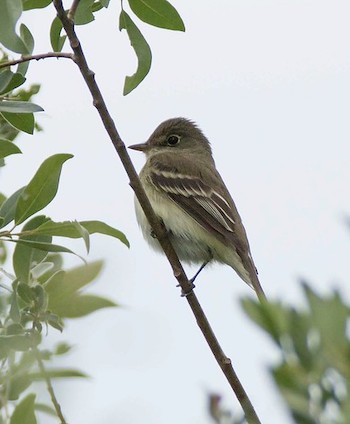
An Alder Flycatcher. Photo by Aaron Bugdor.
A study of molt in three species of Empidonax Flycatchers by IBP seasonal biologist Blaine Carnes and co-authored by Pyle is a great example of taking an evolutionary approach to molt. The study looked at the molts and plumages of Yellow-bellied (Empidonax flaviventris), Least (E. minimus), and Alder (E. alnorum) flycatchers, three species that do at least some of their molting on their wintering grounds in Central and South America. The researchers found that these species have fairly complex molt strategies (because Empidonax never make it easy!). They start their preformative and prebasic molts on the breeding grounds, suspend them migration, and complete them on the wintering grounds, where they also undergo prealternate molts. Previously our understanding of molts on the winter grounds were muddled, but by taking a sequence-based approach, the molts of each species become much clearer and can be compared to each other in an evolutionary sense. To add to the complexities, the start of the prealternate molting sequence can overlap with the end of those of the prior molts. To put these molt strategies in an ecological context, the researchers relate the extent of each of these molts to the latitude and habitat used by each species. Latitude and habitat affect the amount of solar radiation exposure and food resources experienced by birds while they are growing new feathers- both of which affect feather quality.
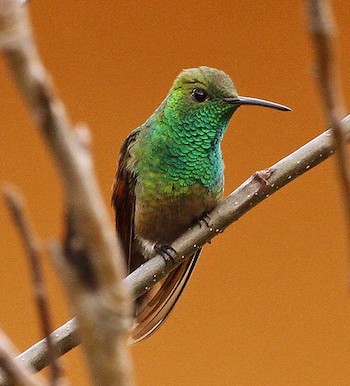
A Berylline Hummingbird. Photo by Mark Watson.
Pyle also examined molt in another complex group, eight hummingbird species (in eight different genera) that breed in Texas and the Southwestern US. This study was recently published in the Wilson Journal of Ornithology. The molt strategies in these species were poorly understood but Pyle was able to fully describe them while sitting at his laptop! He conducted this study by examining over 27,000 digital photographs located at the Cornell Lab of Ornithology’s Macaulay Library, most of which are contributed via eBird. Typically molt is studied via careful examination of a bird in the hand during banding or by examining museum specimens, but Pyle has pioneered the use of digital photographs to study molt, and in this paper he lays out a roadmap for others interested in this approach. (At the conclusion of this study Pyle makes a request to those loading photographs into eBird: please take photos of birds in molt, no matter how ragged and unappealing they look! Over 50% of the images Pyle encountered were of glittering adult males (like the Berylline hummingbird pictured here) which, while aesthetically pleasing, tell us very little about molt strategies.)
Understanding molt can also help solve mysteries, such as unusual reddish feathers observed recently in Western Tanagers in non-breeding plumage (i.e. when both sexes should be yellow to olive green with gray or black wings.) Pyle teamed up with Jocelyn Hudon of the Royal Alberta Museum to investigate this and their study was recently published in Western Birds. Similar red pigmentation, or erythrism, has been observed in several eastern North American bird species and traced to a red pigment called rhodoxanthin found in the berries of introduced honeysuckle plants as well as Western Yew arils (fruits.)
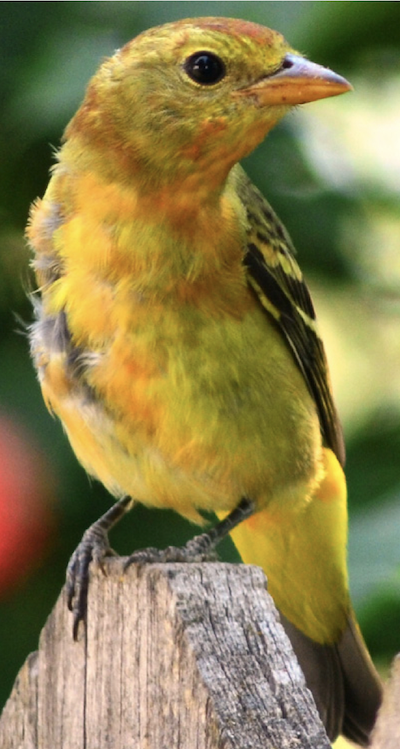
A erythritic Western Tanager, note the reddish feathers on the breast. Photo by Jim Greaves/Macaulay Library.
Using photographs and museum specimens, Hudon and Pyle determined that the reddened tanagers were all first-fall birds that had recently molted into their formative plumage. This is key because these young tanagers are more apt to grow these new feathers on or near the breeding grounds before migration, whereas older tanagers replace these feathers at stopover molting locations, usually in the monsoonal regions of northwestern Mexico. The introduced honeysuckle berries, as well as Western Yew arils, are both available on the breeding grounds during the period when the young birds molt. But these rhodoxanthin containing foods are not available on the molting grounds. Hudon and Pyle documented similar erythrism in western Red-breasted Sapsuckers and Cedar Waxwings as well.
Trying to understand molt can be daunting; even Pyle, who has made molt a focus of his career, will admit this. But as scientists better define and standardize the terminology they use to describe molt, it will become easier to learn and more accessible. The use of modern digital photography to study molt also makes it more accessible. It is no longer necessary to have a bird in the hand, or to visit a museum's specimen collection to make detailed molt observations. As the study of molt advances, more bird enthusiasts- not just molt enthusiasts- will be able to make observations about feather age and replacement and in doing so will gain a new window into the lives of the birds they love.


